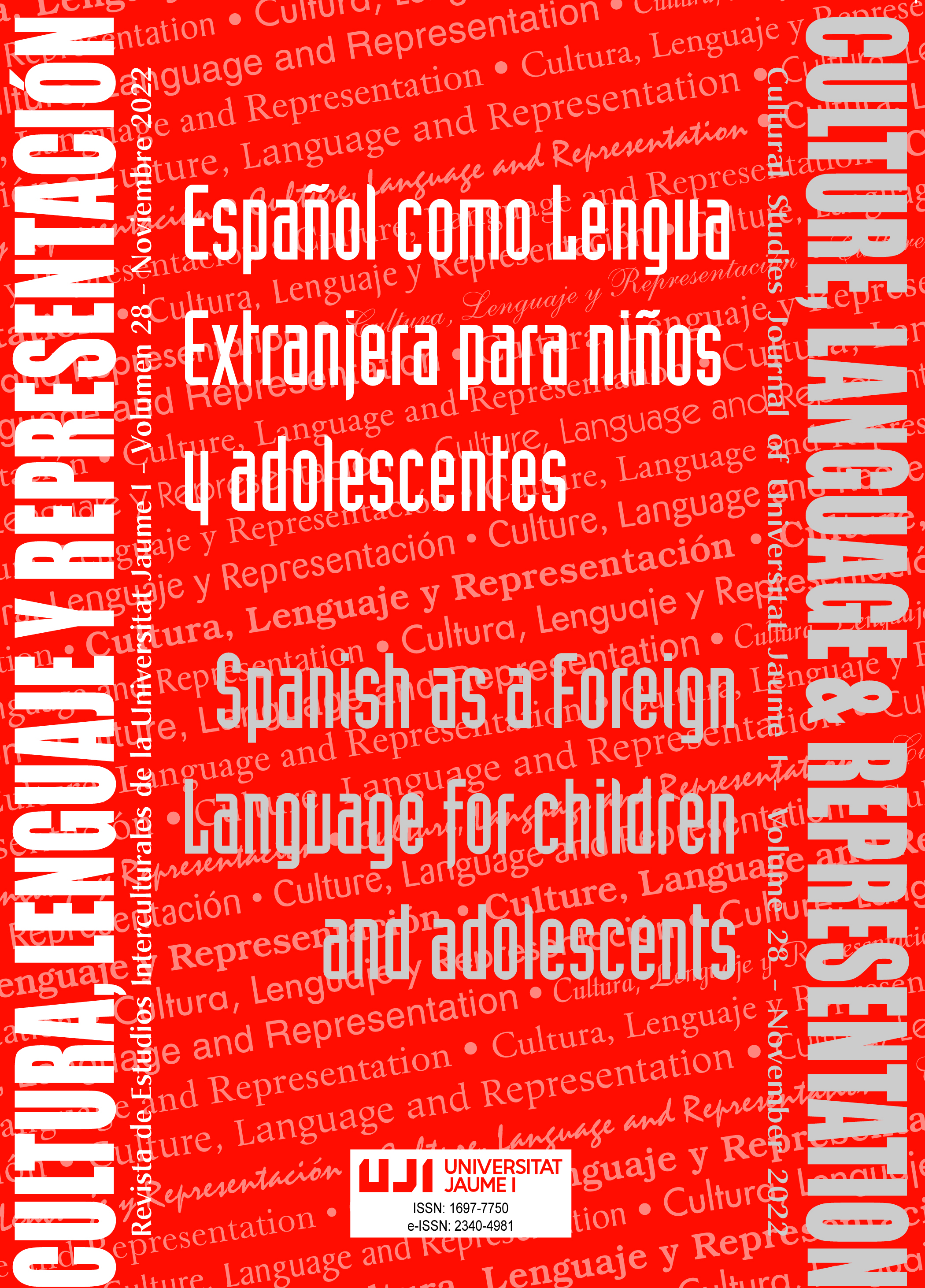Intel·ligències múltiples: claus per al desenvolupament a l'aula d'Espanyol Llengua Estranger per a xiquets
##plugins.themes.bootstrap3.article.main##
Resum
Aquest article dirigeix la seva atenció sobre la teoria de les intel·ligències múltiples de Howard Gardner (1983) i les seves aportacions didàctiques a l'ensenyament espanyol llengua estrangera a nens (ELEN). Des d'aquesta teoria, l'aprenentatge pot ser més complet si es tenen en compte els diferents perfils d'intel·ligències dels alumnes en lloc de negar-los o oferir un ensenyament centrat en una o dues intel·ligències que poden no ser la més freqüent al grup/classe. La justificativa en emprar activitats i pràctiques d'aula inspirades en aquesta teoria rau en la complexitat del procés d'ensenyament/aprenentatge de llengües estrangeres, que necessita l'estímul no només de la intel·ligència lingüístic verbal, sinó de totes les intel·ligències a favor d'un aprenentatge més complet i experiencial. Per afavorir l‟aplicació pràctica d‟aquesta teoria, s‟ofereixen claus didàctiques a partir del marc de cadascuna de les intel·ligències múltiples. El capítol conclou, amb una recapitulació sobre la rellevància d'incloure activitats i pràctiques a l'aula d'ELEN perquè tots els nens tinguin l'oportunitat d'aprendre de la manera que els és més efectiva, i això passa per una classe que contempla múltiples intel·ligències.
Descàrregues
##plugins.themes.bootstrap3.article.details##
S'utilitza una llicència de drets d'autor CREATIVE COMMONS d'accés obert. Aquells autors les obres dels quals siguin publicades per aquesta revista, accepten els termes següents:
- a. Els autors conservaran els seus drets d'autor i garantiran a la revista el dret a publicar primer la seva obra, que estarà simultàniament subjecta a la Llicència de Reconeixement Creative Commons CC BY SA que permet a tercers compartir l'obra sempre que s'indiqui el seu autor i la seva primera publicació.
- b. Els autors podran adoptar altres contractes de llicència no exclusius per a la distribució de la versió publicada de l'obra (per exemple, dipositar-la en un arxiu telemàtic institucional o publicar-la en un volum monogràfic) sempre que s'indiqui la publicació inicial en aquesta revista.
- Els autors poden -i es recomana- difondre la seva obra a través d'Internet (per exemple, en arxius telemàtics institucionals o a la seva pàgina web) abans i durant el procés de presentació, la qual cosa pot produir intercanvis interessants i augmentar les citacions de l'obra publicada.
Referències
Antunes, C. 1998. Estimular las inteligencias múltiples: qué son cómo se manifiesta, cómo funcionan. Madrid: Narcea, S.A. de Ediciones.
Armstrong, T. 2011. Inteligencias múltiples en el aula: guía práctica para educadores.
Madrid: Paidós Educador.
Arnold, J. y Fonseca Mora, M. C. 2004. «Multiple intelligence theory and foreign language learning: A brain-based perspective». International Journal of English Studies, 4: 119–136.
Arnold, J., Puchta, H. y Rinvolucri, M. 2012. ¡Imagínate…!: Imágenes mentales en la clase de español. Madrid: SGEL ELE.
Christison, M. A. 1998. Applying multiple inteligences theory: In preservice and inservice TEFL education programs. V. 36 (2). Disponible en: English Teaching Forum Online:
http://dosfan.lib.uic.edu/usia/E-USIA/forum/vols/vol36/no2/p2.htm [fecha de consulta: 11/06/16].
Consejo de Europa. 2002. Marco Común Europeo de referencia para las lenguas: aprendizaje, enseñanza, evaluación. Madrid: Secretaría General Técnica del MEC, ANAYA e Instituto Cervantes. Disponible en https://cvc.cervantes.es/ensenanza/biblioteca_ele/marco/cvc_mer.pdf
Damasio, A. 2006. El error de Descartes: la emoción, la razón y el cerebro humano, trad.
J. Domènec Ros. Barcelona: Crítica.
Escamilla González, A. 2014. Inteligencias múltiples: claves y propuestas para su desarrollo en el aula. Barcelona: Graó.
Eusebio, S. 2016. «Planificar una clase de español para niños». En Enseña Español a niños y adolescentes, ed. F. Herrera. Barcelona: Difusión.
Fonseca-Mora, Villamarín y Grao. 2015. «Música y emociones para el aprendizaje de lenguas». Mosaico, 33: 37–46.
Gardner, H. 1983. Frames of Mind: The Theory of Multiple Intelligences. Nueva York: Basic Books.
Gardner, H. 1999. La educación de la mente y el conocimiento de las disciplinas.
Barcelona: Paidós.
Gardner. H. 2000. La educación de la mente y el conocimiento de las disciplinas. Lo que todos los estudiantes deberían comprender. Barcelona: Paidós.
Gardner. H. 2001. La inteligencia reformulada: las inteligencias múltiples en el siglo
XXI. Barcelona: Paidós.
Gardner. H. 2010. La inteligencia reformulada: las inteligencias múltiples en el siglo XXI, trad. Sánchez Barberá. Barcelona: Paidós.
Gardner. 2015. Inteligencias múltiples: La teoría en la práctica. Barcelona: Paidós. Johnson, D. W. y Johnson, R. 1994. Leading the cooperative school (2ª ed.) Edina: MN:
Interaction Book Company.
Martí Contreras, J. 2014. Evaluación del componente gramatical en el enfoque comunicativo por tareas en la enseñanza de Español como Lengua Extranjera. Tesis Doctoral. Universitat de València.
Mora, F. 2014. Neuroeducación: solo se puede aprender aquello que se ama (edición actualizada). Madrid: Alianza.
Prieto, M. D. y Ferrándiz, C. 2001. Inteligencias múltiples y curriculum escolar. Málaga: Ediciones Aljibe.
Richards, J. C. y Rodgers, T. S. 2003. Enfoques y métodos en la enseñanza de idiomas, trad. Castrillo, J. M. y Condor, M. (segunda edición actualizada). Cambridge: Cambridge University Press.
Sánchez Pérez. 2009. La enseñanza de idiomas en los últimos cien años: métodos y enfoques. Madrid: SGEL.
Toscano Fuentes, C. M. 2010. Estudio empírico de la relación existente entre el nivel de adquisición de una segunda lengua, la capacidad auditiva y la inteligencia musical del alumnado. Tesis doctoral. Universidad de Huelva.
Vygotsky L.S. 1978. Mind in society: the development of higher psychological processes.
London: Harvard University Press.
Williams, M. y Burden, R. 1999. Psicología para profesores de idiomas: Enfoque del constructivismo social, trad. A. Valero. Cambridge: Cambridge University Press.


